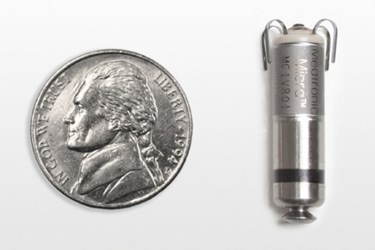Medtronic Successfully Implants World's Smallest Pacemaker

By Jenna Tripke
This week, Medtronic announced the first human transplant of its Micra Transcatheter Pacing System (TPS), the world’s smallest, minimally invasive pacemaker. The device is one-tenth the size of a conventional pacemaker, comparable in size to a large vitamin. Medtronic successfully implanted the tiny pacemaker in a patient in Linz, Austria, as part of a global pivotal clinical trial.
What makes this investigational device so unique, in addition to its small size, is the way that it’s implanted into the heart. Unlike conventional pacemakers, the Micra TPS doesn’t require a surgical incision into the chest. Instead, it’s delivered directly to the heart through a catheter inserted into the femoral vein. Once positioned, the device is secured to the heart wall using small tines, eliminating the need for leads. Electrical impulses are delivered to the heart through an electrode at the end of the device.
In a statement on the Medtronic website, Pat Mackin, president of the Cardiac Rhythm Disease Management business and senior VP at Medtronic, explained: "Less invasive, miniature device technologies show strong promise in improving patient outcomes and implant procedure efficiency. Through our global Micra TPS clinical trial, we intend to generate robust evidence of these benefits to patients and clinicians throughout the world."
The Micra system is expected to have an average battery life of 10 years.
Pacemaker technology is a lucrative business. According to market research firm Axis Research Mind, the global market for cardiac pacemakers will reach $5.1 billion by 2015.
Medtronic isn’t the only company developing small, leadless pacemaker technology. St. Jude Medical boasts the first commercially available leadless pacemaker, which it obtained through the acquisition of Nanostim, Inc., in October. Like the Micra, the Nanostim device is implanted directly into the heart, eliminating the need to surgically create a pacemaker pocket. While not as small as the Micra, the Nanostim — which is about the size of a AAA battery — is already available in select European markets. The device has conditional FDA approval for an investigational device exemption (IDE) in the U.S., and St. Jude plans to start enrolling patients in a trial during the first quarter of 2014.
